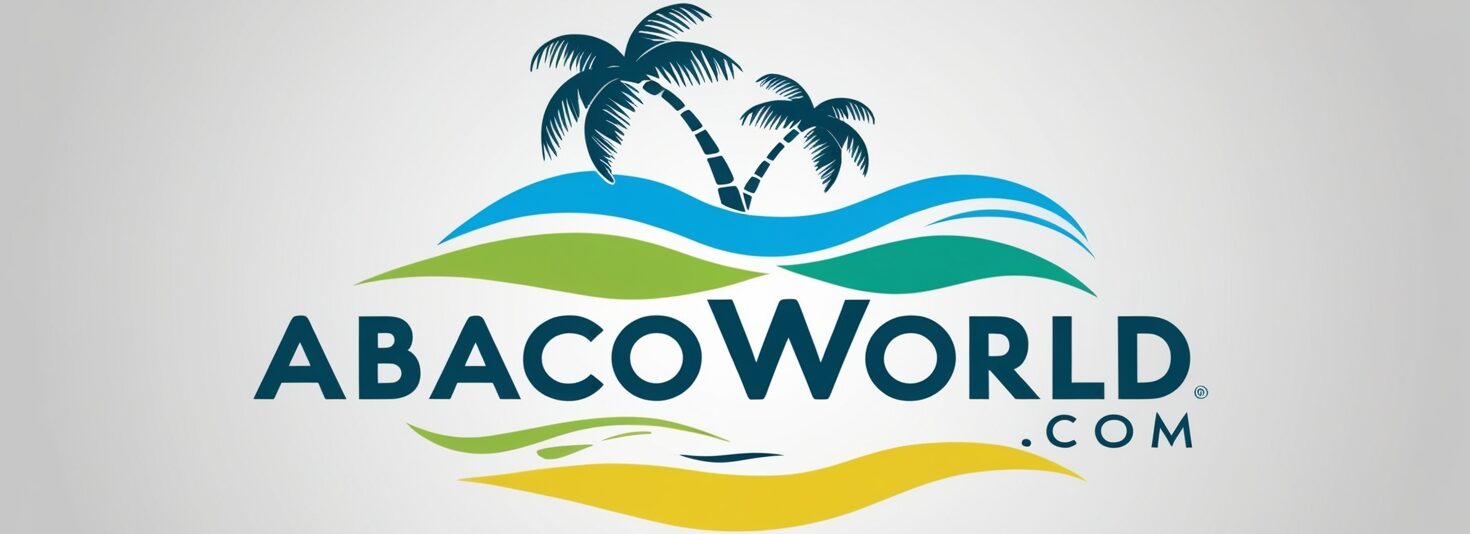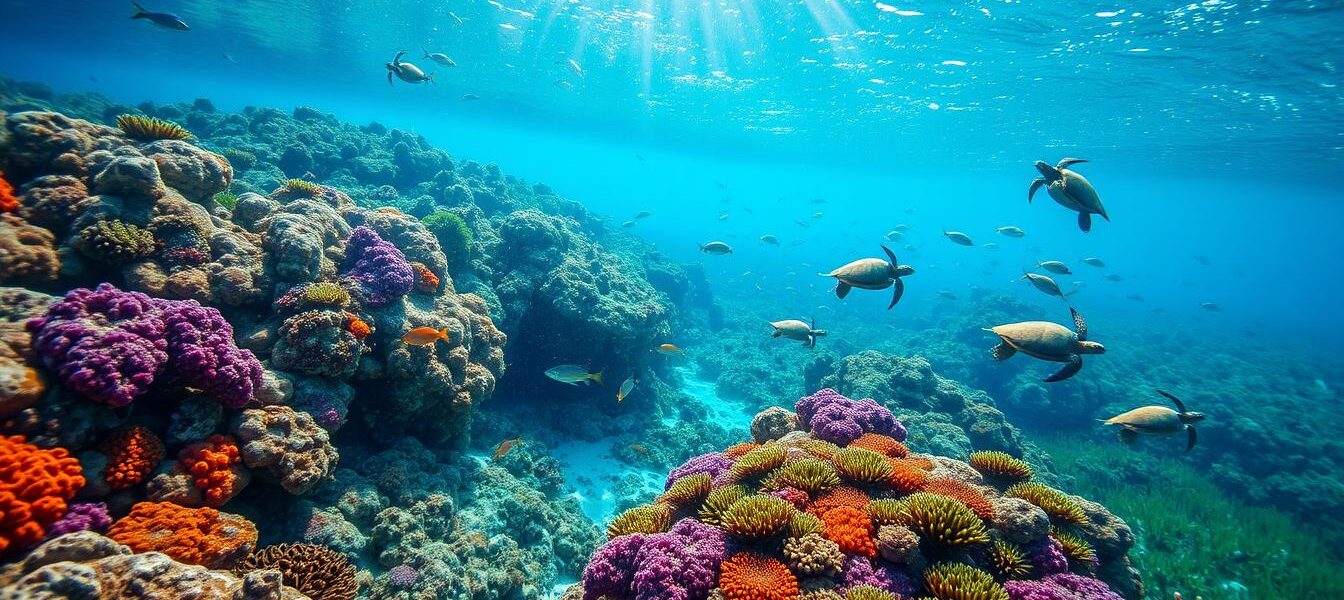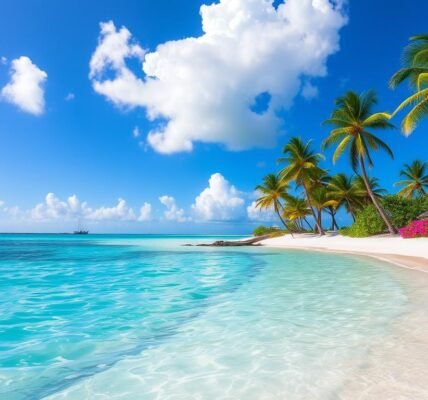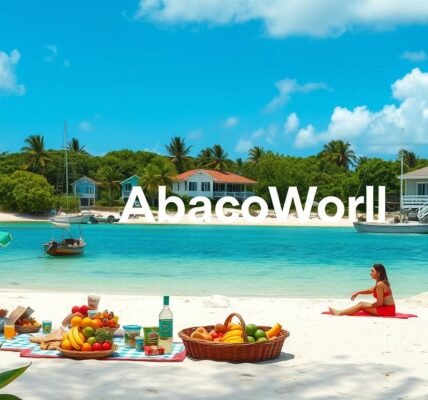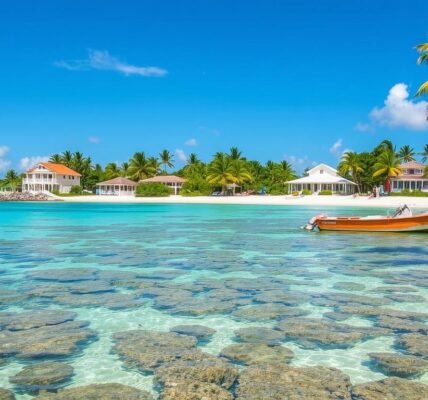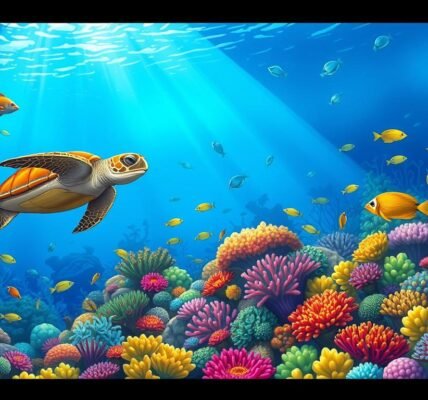“The best time to plant a tree was twenty years ago. The second best time is now.” This Chinese Proverb is very relevant today. It reminds us of the importance of the coral reef in Abaco, a key part of the Caribbean’s marine beauty. The reefs in the Bahamas, especially near Abaco, are vital for many marine species and biodiversity.
But how does Abaco’s reef compare to others? This question is crucial for saving these reefs and supporting tourism. It’s not just about knowing; it’s about acting now to protect these underwater worlds.
Exploring Abaco’s reef shows us the challenges it faces. Environmental threats like climate change and tourism are big concerns. Surveys in Hopetown found 35 coral species, with an average coral cover of 14%1. Most corals were small, but Fowl Cay had some big ones, with 68% over 60 cm1.
Also, the water depths in Abaco vary, from a few feet to over 20 feet2. Knowing this helps us appreciate the reefs’ beauty and the challenges they’re up against.
Key Takeaways
- The coral reef in Abaco features a diverse range of species and ecosystems vital for marine biodiversity.
- Recent surveys show that coral cover in Abaco averages over 14% across various sites.
- Understanding depth variations, from a few feet to over 20 feet, is critical to evaluating reef health.
- Small coral colonies are predominant, but larger colonies can also be found, particularly in Fowl Cay.
- Efforts to conserve this unique ecology are imperative as they face threats from human activity and natural disasters.
Introduction to Coral Reefs in the Caribbean
Coral reefs in the Caribbean are not just beautiful but also crucial for the health of Caribbean marine ecosystems. They cover only a small part of the ocean floor but are home to about 25% of all marine life. This shows their huge role in keeping the ocean healthy3. In The Bahamas, a third of all Caribbean coral reefs are found, making it a key area for marine life3.
The importance of coral reefs goes beyond their role in the ocean. They protect coastlines from erosion and create homes for many sea creatures. They also support local jobs, especially in tourism and fishing. Healthy reefs draw in tourists for snorkeling and diving, boosting the local economy and enhancing their experience.
But coral reefs face many threats, like warmer seas, pollution, and too much fishing. These dangers can cause coral to bleach, harming the life that depends on them. The Abaco Islands have coral cover of just over 14%, showing the reefs are under stress1. Here, small coral colonies are common, while big ones are rare, affecting the reefs’ health1.
Overview of the Coral Reef in Abaco
The Abaco coral reef is a stunning ecosystem with remarkable features. It stretches about 160 kilometers from Walker’s Cay to Elbow Cay. This area is home to diverse coral reef formations in Abaco.
A shallow lagoon protects the reefs from strong waves. It also helps exchange nutrients, keeping the coral healthy.
Geographical Features of Abaco’s Reefs
The Sea of Abaco is vast, spanning around 100 kilometers in length. It is also very wide, over 10 kilometers in some spots4. The sea is dotted with cays like Parrot Cays and Fish Cays.
The Great Abaco Barrier Reef is a highlight here. It’s the third largest barrier reef globally5.
Types of Coral Species Found
Surveys near Hopetown found 35 species of scleractinian corals and two species of calcareous hydrocorals. Most of these corals are small, under 40 centimeters. This shows the variety of types of coral species in Abaco.
The reefs have different structures, like spur-and-groove formations. These help many coral species thrive in Abaco’s special conditions.
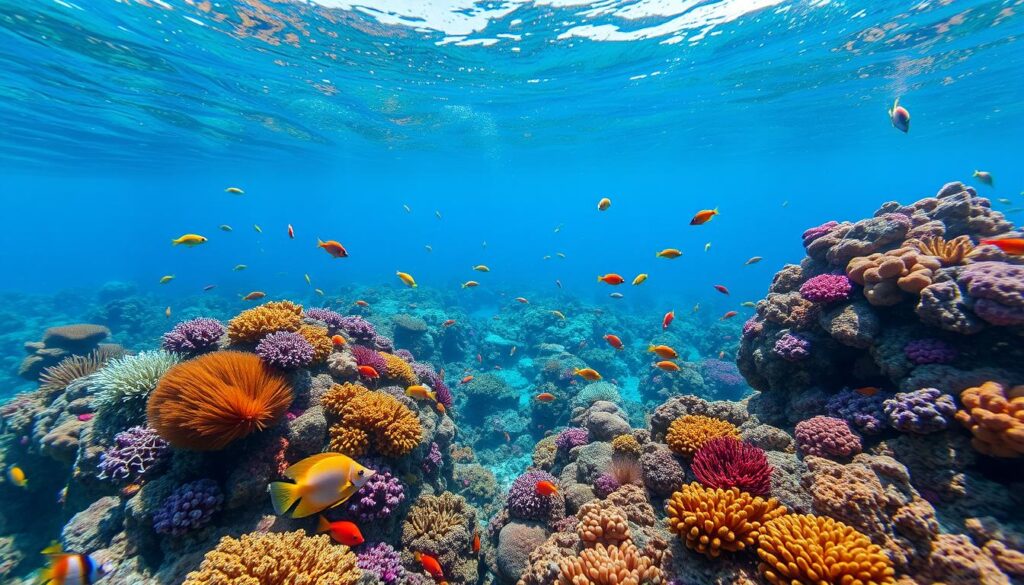
Learn more about saving this ecosystem in the documentary We Among the Reef. It highlights efforts to protect the Abaco coral biodiversity for the future6.
Comparative Analysis of Coral Reefs
Assessing coral reef health involves specific indicators. These coral health indicators include coral cover, species diversity, and disease presence. The Atlantic and Gulf Rapid Reef Assessments (AGRRA) protocol sets benchmarks for marine ecosystem assessment. This allows for comparisons between Abaco’s reefs and other Caribbean locations. Studies on Abaco coral reefs show unique characteristics worth exploring.
Key Indicators for Comparison
Understanding key indicators is crucial for coral health assessment. The AGRRA methodology has provided significant insights into coral vitality and ecosystem integrity. Recent research found that up to 30% of Abaco’s reefs show resilience despite environmental stressors7.
Comparing data with other Caribbean regions highlights the impact of unique geological conditions on coral health8.
Previous Research Findings
Past coral reef research shows that Bahamas reefs, especially around Abaco, face different challenges. Assessments from the last two years cover over 70 reefs, providing insights into coral health and recovery7. Advances in Biorock technology also show promise in accelerating coral growth and ecosystem regeneration9.
These findings support ongoing conservation efforts and strategies to enhance coral resilience in marine environments.
Coral Reef in Abaco: Vital Statistics
The health of coral reefs in Abaco is key to the area’s ecological balance. Recent data shows a worrying trend. Only about 14% of areas are now covered by coral.
This is concerning because coral reefs are vital for marine life and the ecosystem’s strength. They support a wide range of species and help keep the environment healthy.
Average Coral Cover and Biodiversity
Exploring Abaco’s underwater world reveals its rich biodiversity. The unique geography here supports many marine species. However, coral cover statistics indicate a decline in coral health.
This decline affects the balance of the ecosystem and the species that rely on it. The once-thriving ecosystem has been hit hard by environmental stressors.
Impact of Hurricane Dorian on Abaco’s Reefs
Hurricane Dorian had a devastating effect on Abaco’s reefs. It damaged about 30% of the coral in surveyed areas. The storm caused coral bleaching and burial under debris, leading to a drop in fish biomass.
Despite the challenges, some reefs are showing signs of recovery. This suggests they could bounce back if protected from further harm. Monitoring the reefs’ health over time is crucial for conservation efforts.
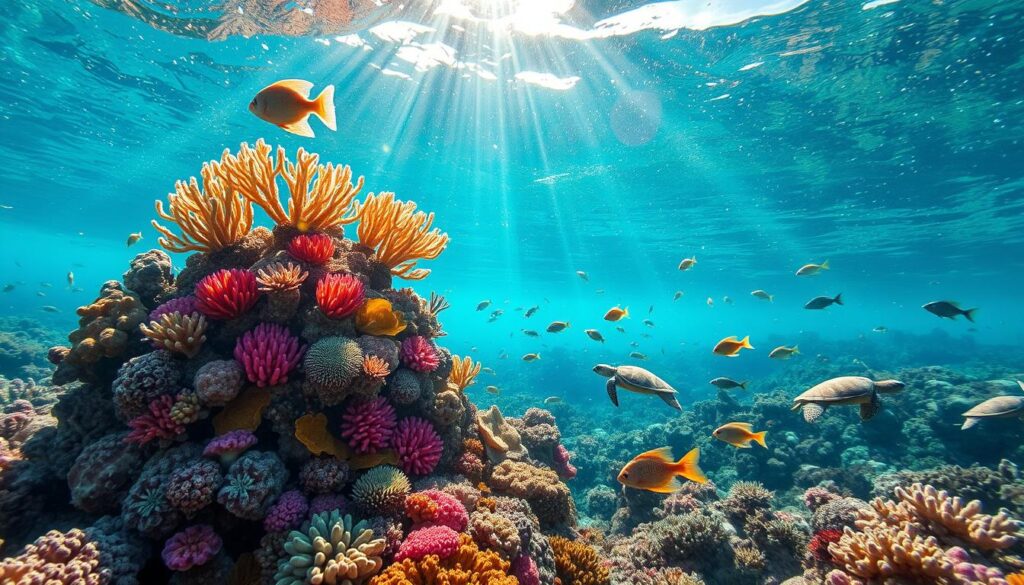
Marine Life in the Abaco Coral Reef
The Abaco coral reef is teeming with life, hosting a wide variety of marine species. You’ll see colorful fish, many invertebrates, and different types of plants. These all work together to keep the ecosystem strong.
The Pelican Cays Land and Sea Park is a key spot for marine life. It covers 2,100 acres of coral reefs. Over 170 marine species call it home, including important ones like Nassau grouper and Queen conch10
Diverse Marine Species
Abaco’s underwater world is full of different species. These species live in various places around the reefs. For example, seabirds nest on rocky cays, and marine mammals swim in the waters.
With 12 protected areas, the reefs get the care they need. This helps keep their biodiversity and strength up11.
Health of Marine Ecosystems
It’s important to watch the health of Abaco’s marine life closely. There’s been more coral bleaching and disease in the Bahamas. This is a big challenge for the health of coral reefs5.
The health of coral reefs affects fish and their homes. To keep the reefs alive, we need good conservation and management. This will help protect the marine life for the future.
Best Diving and Snorkeling Spots in Abaco
Abaco is a paradise for those who love diving and snorkeling. It’s famous for its lively marine life and stunning underwater views. Whether you’re new to diving or have years of experience, there’s something for everyone.
Explore the shallow reefs and meet friendly fish. These moments will stay with you forever. The diving spots cater to all skill levels, from beginners to experts.
Highlighting Abaco’s Top Diving Sites
Abaco’s coral reefs are home to many amazing diving spots. Here are some of the best:
- Fowl Cay: A protected area with a wide variety of marine life, including nurse sharks and angelfish.
- Sandy Cay: With depths of 10 to 20 feet, it’s perfect for underwater photography with its vibrant coral.
- The Hole in the Wall: Near the southernmost point of Great Abaco Island, it offers breathtaking views and diverse marine species.
- Manjack Cay: Known for its calm waters, it’s great for both snorkeling and diving, offering a fun experience for all.
Popular Snorkeling Destinations
Snorkeling in Abaco opens up a world of colorful marine life and beautiful coral. Here are some top spots:
- Elbow Cay: Home to a variety of tropical fish and ideal for snorkeling during the dry season.
- Hope Town Reef: Known for its crystal-clear waters, it’s a favorite among snorkelers and divers.
- Mermaid Reef: Famous for its lively coral and diverse marine life, including spotted eagle rays and pufferfish.
- Pelican Park: A great spot for beginners, offering a family-friendly environment for exploring coral reefs.
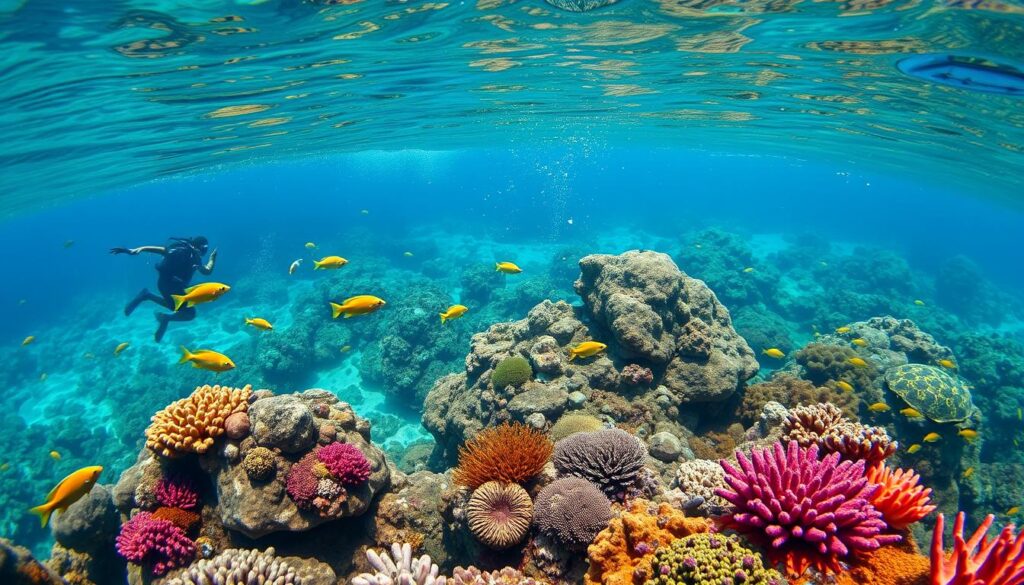
Abaco offers a wide range of diving and snorkeling spots. These places promise an unforgettable journey through its stunning underwater world. The reefs are teeming with life, including sea turtles and colorful fish, making your adventure in the Abacos truly special121314.
Coral Reef Conservation Efforts in Abaco
Abaco’s coral ecosystems need our help to survive. Many marine protected areas work hard to keep them safe from harm. The Fowl Cay Preserve and the Pelican Cays Land and Sea Park are key in this fight. They protect coral and the sea life that depends on it.
Healthy coral reefs are essential for the environment and local communities. They keep the ecosystem balanced and support the local economy.
Protected Marine Areas in Abaco
Abaco has many marine protected areas that help save its reefs. The Fowl Cays National Park has faced problems with grounded vessels since March 27th, 2024. These vessels threaten the coral reefs and the marine life, showing the need for quick action15.
The Bahamas National Trust (BNT) is watching closely. They have the tools to protect the marine life in Abaco.
Community Involvement in Conservation
Local communities are crucial in saving the reefs. Dive operators and fishermen join hands to protect the reefs. They help with clean-ups, education, and support for eco-friendly tourism.
Groups like the Cape Eleuthera Institute and The Nature Conservancy are also key players. They work to save Bahamian coral reefs and include climate change in their plans16. Their efforts show how important community action is for a healthy ocean for the future.
Comparing the Coral Reef in Abaco to Other Caribbean Reefs
Coral reefs in Abaco share similarities with other Caribbean reefs. They face similar environmental challenges like coral bleaching and disease. The recent assessment in Abaco found 35 species of scleractinian corals and two species of calcareous hydrocorals. The coral cover averaged over 14%, showing the diversity of Caribbean reefs17.
Similarities with Other Caribbean Reefs
Abaco’s reefs have structures and species similar to other Caribbean reefs. They share species and roles, showing their connection. Both face challenges like climate change and fishing pressure, needing conservation efforts.
Unique Characteristics of Abaco’s Reef
Abaco’s reefs have unique features that set them apart. They are at the northern limit of shallow reefs, with distinctive structures. Surveys found small colonies were common, but larger ones were found at Fowl Cay pinnacles. Abaco’s reefs are vital for biodiversity, facing pressures from fishing and diving18.
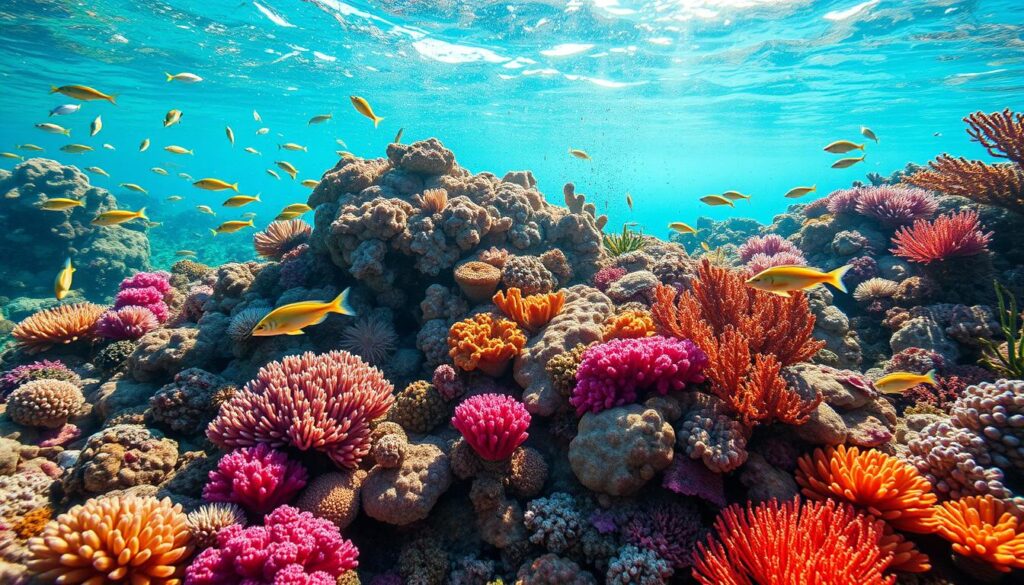
Challenges Faced by Abaco’s Coral Reefs
The coral reefs of Abaco face big challenges from humans and nature. It’s key to know these challenges to keep these ecosystems healthy.
Anthropogenic Impacts
Humans have harmed reefs a lot, mainly through overfishing, building near the coast, and pollution. These anthropogenic pressures damage habitats, making reefs more vulnerable. For example, tourism can lead to more waste, hurting coral health.
Recently, a barge got stuck in Fowl Cay’s National Park, worrying about oil spills. This could harm marine life crucial to reefs19.
Natural Threats
Natural threats, like hurricanes, are big problems for reefs. Hurricanes can destroy reef structures and change how ecosystems work. For instance, Hurricane Dorian damaged Abaco’s reefs a lot.
Reports say 25-30% of reef sites were badly hit by debris, silt, and bleaching like in Abaco20. Also, reefs struggle with temperature changes, making them more vulnerable.
| Type of Threat | Description | Examples |
|---|---|---|
| Anthropogenic | Human activities that degrade coral health | Overfishing, pollution, coastal development |
| Natural | Environmental occurrences damaging coral | Hurricanes, temperature fluctuations |
| Consequences | Effects on coral ecosystem and local economy | Threats to biodiversity, impacts on tourism and fishing industries |
Sustainable Tourism Practices in Abaco
Sustainable tourism in Abaco focuses on eco-friendly tourism and responsible diving. Visitors are urged to help in marine conservation. This way, their actions help the ecosystem.
Through educational programs, tourists learn to respect marine life. This leads to less harm to communities and coral reefs.
Promoting Responsible Diving and Snorkeling
Keeping Abaco’s coral reefs safe is crucial. Responsible diving practices help maintain this balance. Divers can explore the underwater world without harming it.
This approach also boosts the local diving industry. It brings economic benefits to the community.
Impact on Local Communities
Responsible tourism helps Abaco’s people financially. It creates jobs and improves local services. Organizations like Friends of The Environment lead conservation efforts.
This ensures a future for the community. Sustainable tourism in Abaco balances economic growth with environmental care. It creates a peaceful relationship between visitors and nature.
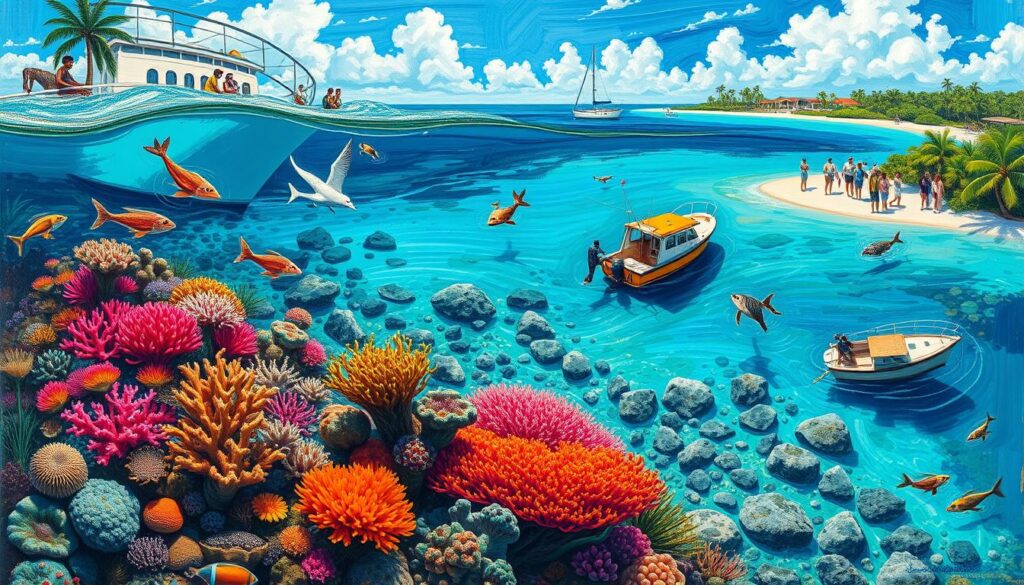
Importance of Research and Monitoring
Understanding coral reef ecosystems is key for their protection and management. Coral reef research and monitoring are vital for checking their health. Studies in Abaco, backed by local experts and groups, look into coral health and species variety. They tackle the effects of environmental changes.
These efforts are the core of good reef management strategies. They help keep coral ecosystems sustainable for the future.
Current Research Initiatives
Research projects, like those by the Khaled bin Sultan Living Oceans Foundation, are crucial. They help us understand Abaco’s coral reefs better. Their work includes mapping reefs to improve habitat maps, which are key for conservation.
Through marine science collaborations, these studies give vital data. This data helps make decisions on coral resilience and recovery from stressors like bleaching.
Data Utilization for Coral Reef Management
Scientists use coral health data to create management plans. These plans are tailored for each reef’s needs. They are vital against threats from climate change and human activities.
The insights from research help make conservation policies better. These policies benefit marine life and the communities that rely on coral reefs. Acting on reliable research data ensures coral reefs’ biodiversity and economic value are preserved.
Future of the Coral Reef in Abaco
The future of coral reefs in Abaco is a big concern. Efforts are underway to keep them alive and strong. It’s important to watch how coral health changes over time. This helps us make better choices to protect the reefs.
Long-term monitoring shows that protected reefs can recover from harm. This is good news for the health of our oceans.
Predictions for Coral Health
New projects are showing hope for Abaco’s coral reefs. A team is working hard to save the reefs from disease. They treated over 200 corals with a disease called SCTLD at Sandy Cay Reef.
They focused on important coral species like Pillar Coral and Mountainous Star Coral. Their success shows the need for ongoing conservation efforts.
Strategies for Improvement
It’s crucial to have good plans to improve coral reefs. Expanding protected areas and working with communities are key steps. Projects like planting 100,000 mangroves help the ecosystem a lot21.
Using advanced monitoring tools gives us important information. This helps us make better choices for the reefs. By working together, we can make a big difference.
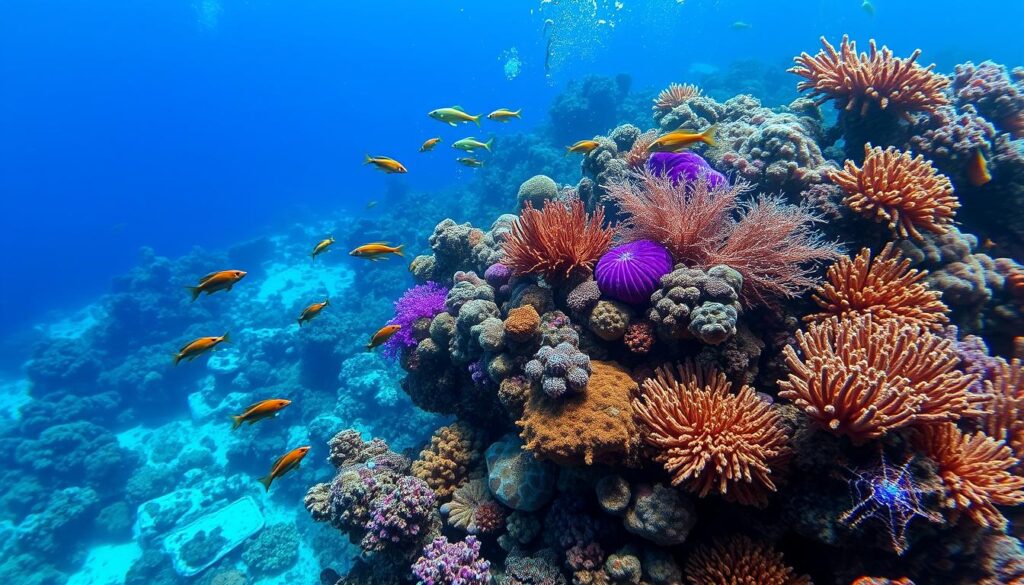
| Strategy | Description | Expected Outcome |
|---|---|---|
| Marine Protected Areas | Expanding designated areas to limit human impact on coral ecosystems. | Increased biodiversity and coral health. |
| Community Engagement | Involving local communities in conservation initiatives. | Enhanced support for reef protection efforts. |
| Coral Monitoring | Utilizing advanced techniques for tracking coral health. | Better-informed decision-making for reef management. |
| Mangrove Planting | Restoring mangrove ecosystems that protect coastal areas. | Support for marine life and erosion control. |
By working together, we can help the coral reefs in Abaco. This ensures they will be healthy for many years to come.
“Coral spawning occurs only a few times a year, influencing future coral populations.”22
Conclusion
The coral reef in Abaco is a key part of the Caribbean’s marine world. It shows a mix of life and importance to the environment. Knowing about this reef helps in saving it for the future.
But, the reef faces big problems like damage from people and Hurricane Dorian. We need to act fast to protect and fix it2324.
It’s important to talk about how vital coral reefs are. Abaco’s reefs are unique and help local jobs and tourism. By saving them, we help our communities and the planet23.
We must work together to save Abaco’s reefs. This means using green practices and studying them more. Together, we can make the sea healthier for all of us.
FAQ
What makes the coral reef in Abaco unique compared to other Caribbean reefs?
How are coral reefs in Abaco significant to the local economy?
What threats do Abaco’s coral reefs face?
How do community efforts contribute to coral reef conservation in Abaco?
What are the best diving and snorkeling spots in Abaco?
How does sustainable tourism impact the coral reef ecosystems in Abaco?
What is the current health of the coral reefs in Abaco?
What research is being done to monitor Abaco’s coral reefs?
Source Links
- https://agrra.org/wp-content/uploads/2016/08/Abacobenthos7-22-03F.pdf
- https://www.traveltalkonline.com/ubbthreads.php/topics/47650/abaco-and-bvi-comparisons.html
- https://breef.org/wp-content/uploads/2020/02/VCRFT-teachers-guide-Feb.-2016-Final.pdf
- https://en.wikipedia.org/wiki/Sea_of_Abaco
- https://rollingharbour.com/marine-life-2/corals/
- https://rollingharbour.com/2022/03/21/elkhorn-coral-reef-life-abaco-bahamas/
- https://www.icriforum.org/wp-content/uploads/2020/05/Hurricane-Dorian-Report-FINAL_compressed-1.pdf
- https://link.springer.com/doi/10.1007/978-90-481-2639-2_42
- https://www.globalcoral.org/gcra-papers/
- https://bnt.bs/explore/abaco/pelican-cays-land-and-sea-park/
- https://www.friendsoftheenvironment.org/protected-areas
- https://www.myoutislands.com/bahamas-islands/abaco/snorkeling
- https://www.abacoescape.com/Snorkel/AESnorkeling.html
- https://www.getmyboat.com/journal/experiences/snorkeling/best-snorkeling-in-the-abacos/
- https://bnt.bs/news/bnt-and-partners-call-for-immediate-action-on-vessels-aground-on-coral-reef-in-abaco/
- https://www.secore.org/site/our-work/detail/bahamas.40.html
- https://nsuworks.nova.edu/cgi/viewcontent.cgi?article=1323&context=occ_facarticles
- https://angari.org/coral-biologists-assess-bahamas-reefs-post-hurricane-dorian/
- https://www.tribune242.com/news/2024/apr/04/environmental-concerns-over-abaco-barge-stuck-reef/
- https://ewnews.com/dreaded-coral-disease-hits-popular-sub-diving-spot-in-the-abacos/
- https://www.perryinstitute.org/watch-we-among-the-reef-a-documentary-on-the-abaco-barrier-reef/
- https://news.miami.edu/stories/2021/09/coral-mama-works-to-save-coral-reefs-from-extinction.html
- https://www.globalcoral.org/golf-courses-kill-coral-reefs-and-fisheries-harmful-algae-blooms-and-disease-caused-by-nutrient-runoff-from-golf-course-development-on-guana-cay-abaco-bahamas/
- https://www.motherjones.com/politics/2019/10/what-did-hurricane-dorian-do-to-the-bahamas-coral-reefs/
